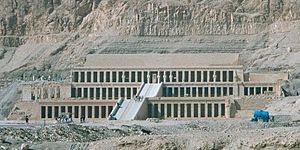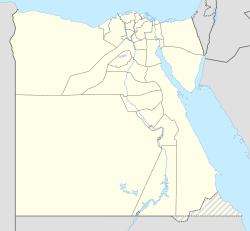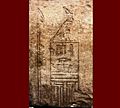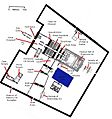Thebes, Egypt facts for kids
|
Waset
Θῆβαι |
|
 |
|
| Location | Luxor, Luxor Governorate, Egypt |
|---|---|
| Region | Upper Egypt |
| Coordinates | 25°43′14″N 32°36′37″E / 25.72056°N 32.61028°E |
| Type | Settlement |
| Official name | Ancient Thebes with its Necropolis |
| Type | Cultural |
| Criteria | I, III, VI |
| Designated | 1979 (3rd session) |
| Reference no. | 87 |
| Region | Arab States |
Thebes (pronounced THEEBZ) was a very important city in Ancient Egypt. It was located about 800 kilometers (500 miles) south of the Mediterranean Sea. The city sat on the east bank of the famous Nile River.
Thebes was the main city of Waset, which was the fourth area, or nome, in Upper Egypt. Today, the ruins of Thebes are part of the modern city of Luxor.
| Preceded by Herakleopolis |
Capital of Egypt 2060 BC - 1785 BC |
Succeeded by Avaris |
| Preceded by Avaris |
Capital of Egypt 1580 BC - c. 1353 BC |
Succeeded by Akhetaten |
| Preceded by Akhetaten |
Capital of Egypt c. 1332 BC - 1085 BC |
Succeeded by Tanis |
Contents
Thebes: A City of Power and History
Thebes was not just any city; it was the capital of Egypt for long periods. This meant it was the center of government and religion. Many pharaohs ruled from Thebes.
Why Thebes Was Important
The city's location on the Nile River was perfect. It allowed for easy travel and trade. The fertile land around it also helped grow crops.
Religious Center
Thebes was especially famous for its religious sites. It was home to the cult of the god Amun-Re. The city had massive temples dedicated to him.
Karnak Temple Complex
The Karnak Temple Complex is one of the largest religious sites ever built. It grew over many centuries. Different pharaohs added to it. It has huge columns, statues, and obelisks.
Luxor Temple
The Luxor Temple is another grand temple in Thebes. It was connected to Karnak by an avenue of sphinxes. This temple was used for important festivals.
Royal Burials and Necropolis
Across the Nile, on the west bank, was the Theban Necropolis. This was a vast burial ground for pharaohs and nobles. It includes famous sites.
Valley of the Kings
The Valley of the Kings is where many pharaohs were buried. Their tombs were hidden deep underground. They were filled with treasures for the afterlife.
Valley of the Queens
The Valley of the Queens was the burial place for queens and royal children. The tomb of Queen Nefertari is here. It is known for its beautiful paintings.
Deir el-Bahari
Deir el-Bahari is a complex of mortuary temples. The most famous is the temple of Queen Hatshepsut. It is built into the cliffs.
Life in Ancient Thebes
Life in Thebes revolved around the Nile and the temples. People worked as farmers, craftsmen, and priests. The city was a bustling center of activity.
Daily Life and People
Ordinary people lived in mud-brick homes. They ate bread, beer, and vegetables. The city was full of markets and workshops.
Art and Craftsmanship
Thebes was known for its skilled artists and craftsmen. They created amazing statues, jewelry, and tomb decorations. Many of these can still be seen today.
The Decline of Thebes
Over time, Thebes lost its status as the sole capital. Other cities became important. It was eventually conquered by different empires.
Later Periods
Even after losing its capital status, Thebes remained a significant city. It continued to be a religious center for centuries.
Thebes Today
Today, the ruins of Thebes are a World Heritage Site. This means it is protected for its importance to human history. Tourists from all over the world visit Luxor. They come to see the ancient temples and tombs.
Exploring the Ruins
Visitors can explore the grand temples of Karnak and Luxor. They can also visit the Valley of the Kings and Queens. These sites offer a glimpse into ancient Egyptian life.
Preserving History
Archaeologists continue to work in Thebes. They uncover new discoveries. This helps us learn more about this amazing ancient city.
Images for kids
-
Serekh of Intef I inscribed posthumously for him by Mentuhotep II
-
Overhead illustration of the Karnak temple
-
A column of Taharqa at the precinct of Amun-Re at Karnak Temple restored to full height
-
Relief in Hathor temple, Deir el-Medina (built during the Ptolemaic Dynasty)
See also
 In Spanish: Tebas (Egipto) para niños
In Spanish: Tebas (Egipto) para niños









